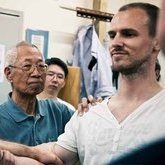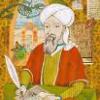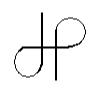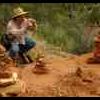-
Content count
3,336 -
Joined
-
Last visited
-
Days Won
12
-

Warm energy radiating from the heart — spontaneous experience after meditation
Mark Foote replied to Kati's topic in General Discussion
Some stuff that's helping me to preserve "one-pointedness of mind", whether at the LDT or elsewhere. I had to write it myself, seems that nobody else has! The initial concentration is induced, said Gautama, by “making self-surrender the object of thought”: … the (noble) disciple, making self-surrender the object of (their) thought, lays hold of concentration, lays hold of one-pointedness. (The disciple), aloof from sensuality, aloof from evil conditions, enters on the first trance, which is accompanied by thought initial and sustained, which is born of solitude, easeful and zestful, and abides therein. (SN 48.10, tr. PTS vol V p 174; “initial” for “directed”, as at SN 36.11, tr. PTS vol IV p 146) In my experience, “one-pointedness” occurs when the movement of breath necessitates the placement of attention at a singular location in the body, and a person “lays hold of one-pointedness” when they remain awake as the singular location shifts. Gautama described the “first trance” as having feelings of zest and ease, and he prescribed the extension of those feelings: … (a person) steeps, drenches, fills, and suffuses this body with zest and ease, born of solitude, so that there is not one particle of the body that is not pervaded by this lone-born zest and ease. (AN 5.28, tr. PTS vol. III pp 18-19) Words like “steeps” and “drenches” convey that the weight of the body accompanies the feelings of zest and ease. The weight of the body sensed at a particular point in the body can shift the body’s center of gravity, and a shift in the body’s center of gravity can result in what Moshe Feldenkrais termed “reflex movement”. Feldenkrais described how “reflex movement” can be engaged in standing up from a chair: …When the center of gravity has really moved forward over the feet a reflex movement will originate in the old nervous system and straighten the legs; this automatic movement will not be felt as an effort at all. (“Awareness Through Movement”, Moshe Feldenkrais, p 78) “Drenching” the body “so that there is not one particle of the body that is not pervaded” with zest and ease allows the weight of the body to effect “reflex movement” in the activity of the body, wherever “one-pointedness” takes place. In falling asleep, the mind can sometimes react to hypnagogic sleep paralysis with an attempt to reassert control over the muscles of the body, causing a “hypnic jerk”. The extension of a weighted zest and ease can pre-empt the tendency to reassert voluntary control in the induction of concentration, and make possible a conscious experience of “reflex movement” in inhalation and exhalation. (Just to Sit) Regarding "one-pointedness of mind" moving to the MDT: I remind myself that the activity of the body in inhalation and exhalation tends toward coordination by the free placement of consciousness, and look for ease. (Applying the Pali Instructions) The practice you mention that really opened your heart, "holding in mind that I would love everyone even if they continued harming", is Gautama's extension of the mind of compassion: [One] dwells, having suffused the first quarter [of the world] with friendliness, likewise the second, likewise the third, likewise the fourth; just so above, below, across; [one] dwells having suffused the whole world everywhere, in every way, with a mind of friendliness that is far-reaching, wide-spread, immeasurable, without enmity, without malevolence. [One] dwells having suffused the first quarter with a mind of compassion… with a mind of sympathetic joy… with a mind of equanimity that is far-reaching, wide-spread, immeasurable, without enmity, without malevolence. (MN 7, tr. Pali Text Society vol I p 48) Gautama said that “the excellence of the heart’s release” through the extension of the mind of compassion was the first of the further concentrations, a concentration he called “the plane of infinite ether” (MN 111; tr. Pali Text Society vol III p 79). (The Inconceivable Nature of the Wind) Wouldja believe, I have a book now, A Natural Mindfulness. Also downloadable for free from my website. -
lantern out. Cat out! out of the bag, disappeared but wait--what's that rub!
-
I don't know why that made me laugh... "T'aint funny, McGee!"
-
My summary of the mindfulness he described as his own, both before and after enlightenment, would be: 1) Relax the activity of the body, in inhalation and exhalation; 2) Find a feeling of ease and calm the senses connected with balance, in inhalation and exhalation; 3) Appreciate and detach from thought, in inhalation and exhalation; 4) Look to the free location of consciousness for the automatic activity of the body, in inhalation and exhalation. (Applying the Pali Instructions) That last is similar to your "stand above the minding".
-
"What are their names, and on what streets do they live, I'd like to ride, ride over..."--David Crosby A thing that is unique in all the religious literature of the world is Gautama's characterization of mindfulness as a function of the four arisings of mindfulness: mindfulness of the body in the body, mindfulness of the feelings in the feelings, mindfulness of the mind in the mind, and mindfulness of the states of mind in the states of mind. How is Zen that?--such a fundamental aspect of Gautama's teaching! Don't mistake me, I believe Zen is that, just wondering if anyone else does.
-
(Omori) Sogen wrote: … It may be the least trouble to say as a general precaution that strength should be allowed to come to fullness naturally as one becomes proficient in sitting. We should sit so that our energy increases of itself and brims over… (“An Introduction to Zen Training: A Translation of Sanzen Nyumon”, Omori Sogen, tr. Dogen Hosokawa and Roy Yoshimoto, Tuttle Publishing, p 59.) Omori quoted one Hida Haramitsu: We should balance the power of the hara (area below the navel) and the koshi (area at the rear of the pelvis) and maintain equilibrium of the seated body by bringing the center of the body’s weight in line with the center of the triangular base of the seated body. (Hida Haramitsu, “Nikon no Shimei” [“Mission of Japan”], parentheticals added; referenced without publisher and date in "An Introduction to Zen Training, above) The equilibrium that Haramitsu described can follow a necessity of breath that places consciousness in the lower abdomen, given a feeling of ease at the point of consciousness and the experience of gravity as the source of activity and stretch. I’m partial to Yuanwu’s “turning to the left, turning to the right, following up behind” (“The Blue Cliff Record” Case 17, tr Cleary & Cleary). If I relax the muscles of the lower abdomen and the muscles behind the pelvis, and calm the stretch of ligaments between the pelvis and the sacrum, gravity can yield a “turning to the left, turning to the right”. “Following up behind” I believe refers to support engaged behind the sacrum and spine: There is… a possible mechanism of support for the spine from the displacement of the fascia behind the spine, a displacement that may depend on a push on the fascia behind the sacrum by the bulk of the extensor muscles, as they contract. There’s a frailty in the structure of the lower spine, and the movement of breath can place the point of awareness in such a fashion as to engage a mechanism of support for the spine, often in stages. (Applying the Pali Instructions)
-
books, brushes, inks, cat, all carefully stowed away. Lantern out. Cat out!
-
Working on a post in response to your last question, about "chop wood carry water"--something from that writing: Zen teachers demonstrate the relinquishment of volitive activity in the body in favor of the free location of “one-pointedness of mind”, constantly. Reb Anderson observed such demonstrations in the actions of Shunryu Suzuki: … I remember (Suzuki’s) dharma talks and I remember him in the zendo—that was wonderful teaching. I remember him moving rocks—wonderful teaching. I remember seeing him eat—that was wonderful teaching. He was teaching all the time in every situation. But when he couldn't sit anymore and couldn't walk anymore, he still taught right from there. (Reb Anderson, from a 1995 recording: https://www.cuke.com/people/anderson-reb.htm) In the parlance of Gautama: And what… is the ceasing of action? That ceasing of action by body, speech, and mind, by which one contacts freedom,–that is called ‘the ceasing of action’. (SN 35.146, tr. Pali Text Society vol IV p 85) As to "one-pointedness of mind": In my experience, “one-pointedness” occurs when the movement of breath necessitates the placement of attention at a singular location in the body, and a person “lays hold of one-pointedness” when they remain awake as the singular location shifts. (Just to Si t) “One-pointedness of mind” occurs out of necessity, in the course of an inhalation or exhalation. The subtle necessity of posture or carriage can induce one-pointedness in seated meditation and in daily living, again in the course of an inhalation or exhalation. "Phases" or "levels" in concentration may have to do with the way "one-pointedness of mind" coordinates reflex activity to shift the fascia behind the sacrum and spine rearward to support the nerve exits between vertebrae, and thereby open the body to the placement of "one-pointedness" anywhere in the body. Forsaking "one-pointedness" for the particulars drops the ball, ignoring "one-pointedness" in the apprehension of the particulars also drops the ball. Fortunately we still breathe. Not really levels in the necessity of that, only in opening the body appropriately.
-
"At the head of the bed is Nephthys and at the foot Isis. They are both touching a 'shen' symbol." "In the case of the lungs its obvious that the breath is involved, Isis the in-breath and Nephthys the out." So our up and down, in and out duo is getting ready to pull the plugs on David Copperfield, after which he will magically change places with ol' foxhead?
-
Ahem. Mark Foote bridges ancient wisdom and modern science in this remarkable exploration of seated meditation. Drawing on Gautama Buddha's original teachings, Zen masters from Dogen to Shunryu Suzuki, and contemporary research in biomechanics and neuroscience, Foote reveals how natural, automatic movement in the body emerges when we surrender volition and allow consciousness to find its own place. For practitioners seeking to understand the relationship between body and mind in meditation, A Natural Mindfulness is an invaluable guide.
-
It's a recurring motif in Egyptian pyramid and scroll art. At least I spared you my explanation this time (I was hoping to goad our host into giving one).
-
fickle heart, tongue cat proportioned to the groove Emily's puzzle
-
So he abides fully conscious of what is behind and what is in front. As (he is conscious of what is) in front, so behind: as behind, so in front; as below, so above: as above, so below: as by day, so by night: as by night, so by day. Thus with wits alert, with wits unhampered, he cultivates his mind to brilliancy. (SN 54.19, Pali Text Society vol 5 p 235; emphasis added) That's the Pali Text Society translation. Switching to Sujato Bhikkyu's translation on suttacentral.org for the explanation ('cause I'm too lazy to copy out the PTS translation): And how does a mendicant meditate perceiving before and behind: as before, so behind; as behind, so before? It’s when the perception of before and behind is properly grasped, focused on, borne in mind, and penetrated with wisdom by a mendicant. That’s how a mendicant meditates perceiving before and behind: as before, so behind; as behind, so before. And how does a mendicant meditate as below, so above; as above, so below? It’s when a mendicant examines their own body up from the soles of the feet and down from the tips of the hairs, wrapped in skin and full of many kinds of filth. ‘In this body there is head hair, body hair, nails, teeth, skin, flesh, sinews, bones, bone marrow, kidneys, heart, liver, diaphragm, spleen, lungs, intestines, mesentery, undigested food, feces, bile, phlegm, pus, blood, sweat, fat, tears, grease, saliva, snot, synovial fluid, urine.’ That’s how a mendicant meditates as below, so above; as above, so below. And how does a mendicant meditate as by day, so by night; as by night, so by day? It’s when a mendicant develops the basis of psychic power that has immersion due to enthusiasm, and active effort, with the same features, attributes, and signs by day as by night. And they develop it with the same features, attributes, and signs by night as by day. That’s how a mendicant meditates as by day, so by night; as by night, so by day. And how, with an open and unenveloped heart, does a mendicant develop a mind that’s full of radiance? It’s when a mendicant has properly grasped the perception of light, and has properly grasped the perception of day. That’s how, with an open and unenveloped heart, a mendicant develops a mind that’s full of radiance. (SN 51.20) You can perhaps see why I prefer the PTS translations in the above. Nevertheless! As to "as before, so behind; as behind, so before", where the Gautamid took a pass on the explanation, bear with me: In my experience, “one-pointedness” occurs when the movement of breath necessitates the placement of attention at a singular location in the body, and a person “lays hold of one-pointedness” when they remain awake as the singular location shifts. The weight of the body sensed at a particular point in the body can shift the body’s center of gravity, and a shift in the body’s center of gravity can result in what Moshe Feldenkrais termed “reflex movement”. The Tai Chi master Cheng Man Ch’ing wrote: In general, what the ancients called, “straightening the chest and sitting precariously,” has to do with the work of self-cultivation. … Therefore, I advise practitioners of T’ai-chi ch’uan to straighten their spines. Holding the spine erect is like stringing pearls on top of each other, without letting them lean or incline. However, if one is too tense and stiff, or unnaturally affected, then this too is an error. (“Master Cheng’s Thirteen Chapters on T’ai-Chi Ch’uan”, © 1982 Douglas Wile, p 21) I would say that the thread on which the pearls are strung is the fascia behind the sacrum and spine, the thoracolumbar fascial sheet, composed of the thoracolumbar and nuchal fascia. “Stringing pearls” is allowing the abdominals to work with the extensor muscles of the spine to align vertebrae and thereby permit the displacement of the fascial sheet. Gravity in the abdominals can work against the extensors in a rhythm regulated by the stretch of ligaments, while pressure created in the abdomen as the abdominals work can displace the fascia behind specific vertebrae in support of an overall stretch. Because the extensor muscles behind the sacrum are enclosed by bone on three sides, the thoracolumbar fascia behind the sacrum can be displaced by the mass of the extensor muscles as they contract. Gravity in the muscles of the lower abdomen and pelvis can work against the extensors, again regulated by the stretch of ligaments, to displace the fascia behind the sacrum in support of an overall stretch. I find that Gautama’s description of ease in the second concentration accords well with the engagement of “reflex movement” in the lower abdomen, around the pelvic basin, and behind the sacrum. Likewise, Gautama’s description of ease in the third concentration accords well with “reflex movement” in the abdominals and in the extensors of the spine. (Just to Sit) That's "before as behind, behind as before" to me. "As below, so above: as above, so below"--Gautama got in trouble for recommending the "meditation on the unlovely (aspects of the body)", which appears to be what he's describing here. I find "as below, so above: as above, so below" in the overall stretch of the fascia behind the sacrum and spine, which involves the whole body. "(The monk has) properly grasped the perception of light, and has properly grasped the perception of day". Pali Text Society has "(a monk's) “consciousness of light is well grasped, his consciousness of daylight is well-sustained" (which I prefer).
-
-
For Theravadin Buddhists, democracy is the name of the game when it comes to decisions of the order. Except that the group that would remain the Theravadins decided after the vote in B.C. 349 to take their dry sleeping robes and go home, what a bunch of party poopers! Intuitions we have about the way the world works rarely conflict with our everyday experience. At speeds far slower than the speed of light or at scales far larger than the quantum one, we can, for instance, assume that objects have definite features independent of our measurements, that we all share a universal space and time, that a fact for one of us is a fact for all. As long as our philosophy works, it lurks undetected in the background, leading us to mistakenly believe that science is something separable from metaphysics. But at the uncharted edges of experience — at high speeds and tiny scales — those intuitions cease to serve us, making it impossible for us to do science without confronting our philosophical assumptions head-on. Suddenly we find ourselves in a place where science and philosophy can no longer be neatly distinguished. A place, according to the physicist Eric Cavalcanti, called “experimental metaphysics.” https://www.quantamagazine.org/metaphysical-experiments-test-hidden-assumptions-about-reality-20240730/ I know, not what you were referencing...




.thumb.jpg.0279361507cce6eb60b037b7a68d8dc9.jpg)











